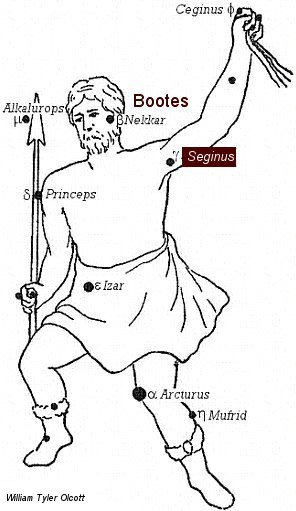| Fixed star: SEGINUS | |
| Constellation: Gamma (γ) Bootes | |
| Longitude 1900: 16LIB16 | Longitude 2000: 17LIB40 |
| Declination 1900: +38.45′ | Declination 2000: +38.19′ |
| Right ascension: 14h 31m | Latitude: +49.32′ |
| Spectral class: A7 | Magnitude: 3.0 |
The history of the star: Seginus
from p.103 of Star Names, Richard Hinckley Allen, 1889.
[A scanned copy can be viewed on this webpage

Seginus appears on Burritt’s Atlas from the Ceginus of the constellation Bootes (which had that Arabic title). [Wikipedia explains: The name Seginus resulted from Latinization of an Arabic form of the Greek name of the constellation of Boötes (Theguius). The name Haris comes from the Arabic name of the constellation of Boötes, Al Haris Al Sama, which means “the guard”.]
Manilius (1st century A.D.) termed it prona Lycaonia, “sloping towards, or in front of, Lycaon,” referring to the Greater Bear, as the star marks the left shoulder of Bootes near to that constellation (Ursa Major) [the title Lycaonia for the constellation Ursa Major is because that constellation is identified with Callisto the daughter of Lycaon; Bootes constellation had a title Lycaon, the father or grandfather of Callisto]; and Euripides similarly wrote in his Ion of about 420 B.C.:
“Above, Arcturus to the golden pole inclines.”
The French astronomer Flammarion gives to it the Alkalurops that is better recognized for mu (μ) Bootes. The Chinese called it Heuen Ko, the Heavenly Spear.
It is interesting to know that the variable nu (ν) is in the telescopic field with gamma (γ Seginus).
This star, gamma (γ Seginus), with beta (β Nekkar), delta (δ Princeps), and mu (μ Alkalurops), constituted the trapezium Al Dhi’bah, the Female Wolves, or, perhaps, Hyaenas, an early asterism of the Arabs before they adopted the Greek constellation; these animals, with others similar shown by stars in Draco and near it, lying in wait for the occupants of the ancient Fold around the pole (Polaris).
Star Names, Their Lore and Meaning, Richard Hinckley Allen, 1889].
The astrological influences of the constellation Bootes
Legend: Bootes is identified with Icarius, who was killed by some shepherds he had made drunk with a flagon of wine given him by Bacchus/Dionysus. In consideration of the grief of his daughter Erigone and their hound Maera, Jupiter placed her father in heaven as Bootes, together with herself as Virgo and the hound became one of the Dogs; some say Canis Minor, others say Canis Major
Influences: According to Ptolemy the influence of the constellation is like that of Mercury and Saturn, though the star Arcturus is like Mars and Jupiter. It is said to give prosperity from work, strong desires, a tendency to excess, a fondness for rural pursuits, together with some liking for occultism. The Kabalists associate it with the Hebrew letter Teth and the 9th Tarot Trump, “The Hermit”. [Robson, p.32.]
The astrological influences of the constellation Bootes given by Manilius:
“True is the name men have given him (the Bearwarden), threatening-like he presses forward as one does over a team of bullocks. To those born under Arctophylax – Arcturus, fortune herself makes bold to entrust her treasures, so that the wealth of monarchs and temple finances will be in their keeping [translator’s note: custodianship is a suitable endowment for the Bearward]; they will be kings under kings and ministers of state [politicians], and be charged with the guardianship of the people or, as the stewards of grand houses, they will confine their business to the care of another’s home.” [Translator’s note: strictly speaking Arcturus is a star, but the name is used by ancient astrologers for the whole constellation of Bootes and for the star alone, it is often difficult to distinguish which of these the authors are referring to]. [Manilius, Astronomica, 1st century AD, book 5, p.329.]
The astrological influences of the star Seginus
It gives a subtle mind, shamelessness and loss through friends and companies. [Robson, p.207.]
On the left shoulder of Bootes has the star gamma, γ, Seginus, a word coming from Latin for corn-crop, and thus meaning a reaper or harvester. In some illustrations Bootes hold a reaping sickle in his hand. To the Arabs it is Al Haris, the Guard or Protector. With its Mercury-Saturn simile it emphasizes the protective nature of Bootes, and ourselves. The planetary connotation also shows up well the potential for writing or public speaking in those who have it in their horoscopes. [The Living Stars, Dr. Eric Morse, p.142.]
With Moon: Preferment by indirect means followed by disgrace and ruin. [Robson, p.207.]
References:
Fixed Stars and Constellations in Astrology, Vivian E. Robson, 1923].